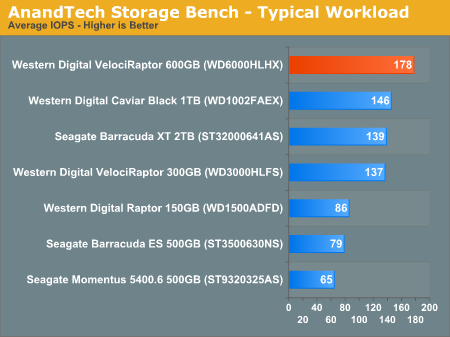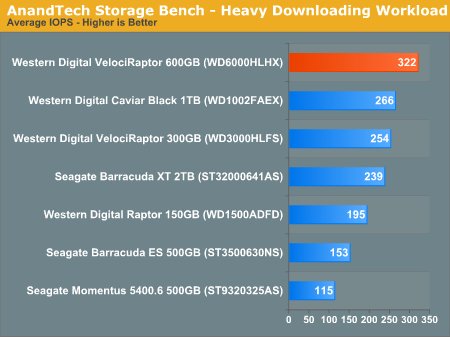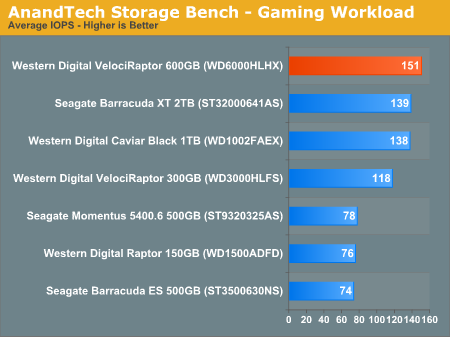Western Digital's New VelociRaptor VR200M: 10K RPM at 450GB and 600GB
by Anand Lal Shimpi on April 6, 2010 8:00 AM EST- Posted in
- Storage
AnandTech Storage Bench
The first in our benchmark suite is a light usage case. The Windows 7 system is loaded with Firefox, Office 2007 and Adobe Reader among other applications. With Firefox we browse web pages like Facebook, AnandTech, Digg and other sites. Outlook is also running and we use it to check emails, create and send a message with a PDF attachment. Adobe Reader is used to view some PDFs. Excel 2007 is used to create a spreadsheet, graphs and save the document. The same goes for Word 2007. We open and step through a presentation in PowerPoint 2007 received as an email attachment before saving it to the desktop. Finally we watch a bit of a Firefly episode in Windows Media Player 11.
There’s some level of multitasking going on here but it’s not unreasonable by any means. Generally the application tasks proceed linearly, with the exception of things like web browsing which may happen in between one of the other tasks.
The recording is played back on all of our drives here today. Remember that we’re isolating disk performance, all we’re doing is playing back every single disk access that happened in that ~5 minute period of usage. The light workload is composed of 37,501 reads and 20,268 writes. Over 30% of the IOs are 4KB, 11% are 16KB, 22% are 32KB and approximately 13% are 64KB in size. Less than 30% of the operations are absolutely sequential in nature. Average queue depth is 6.09 IOs.
The performance results are reported in average I/O Operations per Second (IOPS):

Performance in our real world benchmark however makes it very clear that no other hard drive is as fast as the 600GB VelociRaptor. WD delivers a nearly 30% improvement over the old drive, and 22% better performance than the new Caviar Black series.
If there’s a light usage case there’s bound to be a heavy one. In this test we have Microsoft Security Essentials running in the background with real time virus scanning enabled. We also perform a quick scan in the middle of the test. Firefox, Outlook, Excel, Word and Powerpoint are all used the same as they were in the light test. We add Photoshop CS4 to the mix, opening a bunch of 12MP images, editing them, then saving them as highly compressed JPGs for web publishing. Windows 7’s picture viewer is used to view a bunch of pictures on the hard drive. We use 7-zip to create and extract .7z archives. Downloading is also prominently featured in our heavy test; we download large files from the Internet during portions of the benchmark, as well as use uTorrent to grab a couple of torrents. Some of the applications in use are installed during the benchmark, Windows updates are also installed. Towards the end of the test we launch World of Warcraft, play for a few minutes, then delete the folder. This test also takes into account all of the disk accesses that happen while the OS is booting.
The benchmark is 22 minutes long and it consists of 128,895 read operations and 72,411 write operations. Roughly 44% of all IOs were sequential. Approximately 30% of all accesses were 4KB in size, 12% were 16KB in size, 14% were 32KB and 20% were 64KB. Average queue depth was 3.59.

Upping the number of writes doesn't change anything, the new VR is 26% faster than the old one and 21% faster than the best 7200 RPM drives. Keep in mind this is pure I/O performance, the real world performance is most likely in the 3 - 10% range on average which is what we saw in PCMark Vantage and SYSMark 2007.
The gaming workload is made up of 75,206 read operations and only 4,592 write operations. Only 20% of the accesses are 4KB in size, nearly 40% are 64KB and 20% are 32KB. A whopping 69% of the IOs are sequential, meaning this is predominantly a sequential read benchmark. The average queue depth is 7.76 IOs.

Sequential read performance is solid on the new VR, but not that much better than other, larger (and cheaper) drives on the market. Western Digital's advantage over the old VR is a healthy 27%, but over newer 7200 RPM drives it's barely 9%.










77 Comments
View All Comments
Makaveli - Tuesday, April 6, 2010 - link
I really think they should have gone with 300GB's platters dropped the 450GB model and release just a single platter 300GB's model and 2 platter 600GB model. Sell the 300GB model for $199 and the 600GB model for $299.I'm already using Intel SSD + 1TB Black for storage so I won't be buying one, raptors are dead to me!
efeman - Tuesday, April 6, 2010 - link
I have two VR150's in RAID-0. Is there any chance you could compare performance of the new VR's to that (or two VR300's, of course).Hacp - Tuesday, April 6, 2010 - link
Dear Anand,It would be helpful if you had some random latency tests, because that is what makes mechanical drives so horrible. Also, would be helpful if you did some short stroked benchmarks with this drive. Finally, I would like to compare it to an SSD drive. I know you are short on time but it would really make the review more interesting. Keep up the good work.
Anand Lal Shimpi - Tuesday, April 6, 2010 - link
The random tests actually give you latency, just represented in MB/s instead of ms.For example:
4KB random write test, 3 outstanding IOs:
VR200M got 1.9MB/s average write speed
That's 1945.6 KB/s (1.9MB/s * 1024KB/MB), which is 486.4 IOPS (1945.6KB/s / 4KB/IOP). That gives us IOs per second, or if we take the inverse we get seconds per IO: 2.05ms. Now since we've got 3 outstanding IOs that's 3 x 2.05ms or 6.16ms.
Latency is represented, just in the form of MB/s :)
Take care,
Anand
AstroGuardian - Tuesday, April 6, 2010 - link
Anand, please if you feel like telling us; you mentioned you have 1 x SSD and 2 x 1Tb drives in you personal computer in RAID1. What kind of 1Tb drives did you put there?Just a curiosity. I would like to know what your choice was...
Cheers
Anand Lal Shimpi - Tuesday, April 6, 2010 - link
I've got a pair of old Hitachi 1TB HDT721010SLA360 drives in my machine. I just used them because I had them laying around with no other purpose :)Take care,
Anand
pjconoso - Tuesday, April 6, 2010 - link
Are you actually using them? :) I could use a couple of those - 'wouldn't mind if they're slow as hell, lol.AstroGuardian - Wednesday, April 7, 2010 - link
Naaah dude, those drives are just great. We have plenty of those here in Europe. I have seen many defective Seagates, Spinpoints, few WDs but i have never seen a dead Hitachi (except for one of mine which i sent to death myself one angry morning...).Great choice Anand, but i still kind a think you chose those drives for a reason (what could that be lol) and not just because they were laying around. Haha....
strikeback03 - Thursday, April 8, 2010 - link
We have had one Hitachi, a Maxtor, a few Seagates, and a bunch of Samsung Drives die here at work.AstroGuardian - Thursday, April 8, 2010 - link
Haha, there you go. The Samsungs die every day. I have no idea what their issues are, especially those F3 - RAID Class drives. About the Maxtor i think it's time has come to pass away don't you think? Hehe